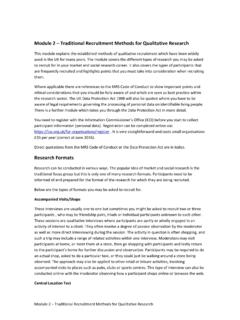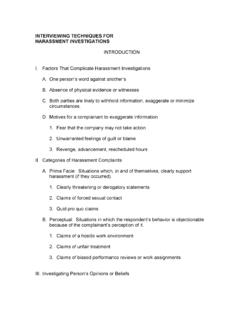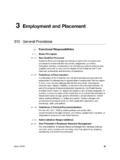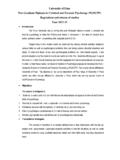Transcription of MRS Guidance Note on Collecting Data on Sex and …
1 January 2016 1 MRS Guidance Note on Collecting data on Sex and Gender January 2016 January 2016 2 MRS Guidance Note on Collecting data on Sex and Gender MRS has produced this Guidance Note to help practitioners act legally and ethically when Collecting data and asking research participants questions on biological sex, gender and gender identity. All research participants need to feel equally valued and satisfied that their personal preferences are being respected in terms of how they wish to describe and categorise themselves. Researchers can use this Guidance to assess whether they are complying with the Code in Collecting demographic information on these areas. This should be used in conjunction with the MRS Code of Conduct and Guidelines. Explanation of Key Terms Biological sex refers to a person s physical anatomy. In most cases the terms male and female will cover biological sex but there are a range of other variations in anatomy and chromosomal makeup which will require an additional classification such as intersex.
2 Intersex refers to a range of physical, hormonal or genetic features, present but not necessarily evident at birth, which are neither wholly female nor wholly male or are a combination of female and male. Gender and gender identity is complicated. It is the way that an individual describes themselves and identifies with a gender category. A person s identity may or may not correspond with their biological sex and is quite separate and distinct from their sexual orientation. It is also not fully covered by the standard Male and Female categories. The wide range of non-binary gender identities means that some people may identify as male or female and some may identify with an alternative third option gender identity such as transgender. Other identities may include polygender, intergender, nongender, agender or transsexual. In short, gender identity may not be static and it can be complex.
3 Transgender is an umbrella term generally used where a person s gender identity differs from their sex recorded at birth. January 2016 3 Legal and Regulatory Obligations Under the MRS Code of Conduct 2014 it is important to allow participants to express their views in the way that they prefer. Breaching this requirement can leave your activities open to investigation under the MRS disciplinary process. Rule 6 of the MRS Code of Conduct: Members must take all reasonable precautions to ensure that participants are not harmed or adversely affected by the member s professional activities. Rule 33 (c) of the MRS Code of Conduct: Members must take reasonable steps to ensure .. c. that participants are able to provide information in a way that reflects the view they want to express, including don t know/prefer not to say where appropriate. The data Protection Act 1998 sets out a core requirement to have a legal basis for processing personal data .
4 The guiding construct can be summarised as informed consent of individuals being asked for or providing information about themselves. There is also a body of UK legislation that protects the rights of transsexual individuals (who have undergone medical intervention). These together with the provisions in the data Protection Act are important in reinforcing the need to respect the privacy of an individual s sensitive personal health data : Sex Discrimination (Gender Reassignment) Regulations: protects transsexual people against discrimination in employment and vocational training. Gender Recognition Act 2004: provides a mechanism for someone to be legally recognised in their adopted gender. Identification of the trans history of a person who does not wish to be identified as having a trans history could lead to prosecution under Section 22 of the Gender Recognition Act.
5 Sex Discrimination (Amendment of Legislation) Regulation (2008): seeks to eliminate unlawful direct discrimination and harassment on grounds of gender reassignment in the provision of goods, facilities and services. Equalities Act: imposes duties on public bodies to include transsexual people in their gender equality schemes. The Equalities and Human Rights Commission (EHRC) recommends that this requirement be extended to all trans people. January 2016 4 Methodological Points Asking broader gender or sex questions, that include options other than male or female, may raise methodological issues for researchers. There is a small risk, with using open-ended questions or including the other option, that participants may give deliberately misleading, wrong or frivolous responses, which could lead to inaccuracy and bias in the data . The change in approach may also impact on male/female quotas for quota sample projects since there is no baseline information on other category.
6 The Office of National Statistics (ONS) only collects statistics on sex or gender classifications of male and female. data collection of demographic information either relies on self-completion tools such as paper or online self-completion forms, or is interviewer aided such as in face-to-face or telephone interviews. For self-completion data collection tools, the best practice Guidance can be implemented in a straightforward manner. On the other hand, asking gender or sex questions when carrying out face-to-face or telephone interviewing requires greater skill and tact. Standard current practice in the sector is for interviewers to complete the gender question based on tone of voice and name. Although this may be appropriate in the majority of situations, in some instances it may be incorrect. Interviewers need to be: trained to recognise when it may be appropriate to offer the other option or prefer not to say provided with sufficient discretion and flexibility to allow them to enter additional categories if a participant indicates that they do not fall into the Male/Female category.
7 MRS recognises that additional research on different ways of asking gender and sex questions would be a useful base for the provision of additional Guidance for interviewers. Key Points: Collection of sex and/or gender information needs to be tailored to the data collection tool. Self-completion tools should at a minimum include an additional field of other for either gender or sex questions. Interviewer-aided techniques for Collecting information need to build in a level of discretion and flexibility for interviewers, to ensure questions are responsive and are handled appropriately. January 2016 5 Sex or Gender Questions It is important that all research participants feel satisfied that their voice is being heard. Allowing participants to provide information in a way that reflects the view they want to express is explicitly set out in the MRS Code of Conduct and this also applies to describing their sex or gender.
8 The categories provided for completion must facilitate and recognise the fluidity of gender identity, by providing an additional option such as free-field other . Key Points: Researchers need to: Be clear as to which category of information they wish to collect - Sex and gender are related but distinct and researchers must choose the right concept. Encourage clients to consider whether the demographic information is relevant This is especially important if considering Collecting trans-history but the appropriate level of detail required for a project should always be reviewed. Rethink the standard binary questions for both sex and gender - Demographic questions on sex and gender must cater for non-binary people. Respect privacy of participants Ensure that steps are taken to maintain the confidentiality of responses. Persons who self-identify as other may be particularly concerned about the privacy of the research.
9 Examples of Gender and Sex Questions Members must ensure that participants will be able to proceed through any research without being required to indicate male or female options if they do not identify as such. This may be achieved by including female, male and other as a (free field) options; allowing participants to self-identify by asking an open-ended question or by adopting a two-step approach that covers assigned sex at birth and then current gender identity. There is no one size fits all answer but examples of questions are set out below: What is your sex? What is your sex? OR What is your gender Female Male Intersex Prefer Not to Say Female Male Other (please specify) Prefer Not to Say January 2016 6 Checklist - Questions to ask Do I need to collect information on either sex or gender? Is there a research purpose for Collecting this information?
10 O Why? o Is it relevant and not excessive? Should I collect information on sex or should I collect gender? o Do I want to match with other data sets or sources? If so, what do they collect? Can I make the answers optional? What response options should I provide? o Should I provide closed categories (including other) or an open field? o Do I want to include an intersex option for sex or an other option? January 2016 7 Gender Identity Questions Establishing best practice in developing and asking gender identity questions will need to build on the position and practice of the ONS and research carried out by the EHRC. This will allow the research community to design and implement a consistent and standard gender identity question that can be understood and answered by all people living in the United Kingdom (UK). MRS is not seeking to develop a gender identity question, but in the interim as different approaches are explored, this Guidance note highlights some of the important additional considerations that should be taken into account in measuring gender identity.







